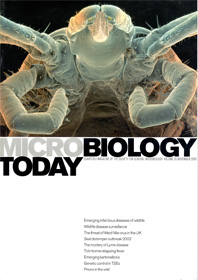Wildlife disease
01 November 2003 publication
The lead articles of the November 2003 issue of Microbiology Today are on wildlife disease surveillance; the threat of West Nile virus in the UK; seal distemper outbreak; the mystery of Lyme disease; tick-borne relapsing fever; emerging bartonellosis; genetic control in TSEs; and prions in the wild.
Emerging infectious diseases of wildlife (p. 155)
Many pathogens are not fussy about their host species. As Sarah Cleaveland describes, this means that wildlife hosts can play a key role in the emergence of human and domestic animal diseases.
Wildlife disease surveillance by the Veterinary Laboratories Agency (p. 157)
From small beginnings, and although necessarily limited by its budget, the VLA Scheme, in collaboration with many organisations, has developed to become the first government-funded project for wildlife disease surveillance in England and Wales. Paul Duff describes the importance of this.
Does West Nile virus pose a threat to the UK? (p. 160)
Recent reports that antibodies to West Nile virus have been found in UK birds have caused concern. Ernest Gould questions what the risks are of this potentially fatal disease to humans in Britain.
Seal distemper outbreak 2002 (p. 162)
Morbilliviruses, the group of viruses for which the human measles virus is the type virus, have recently been found to infect diverse species of marine mammals. Over the past 15 years epizootics of these viruses have caused mass die offs, mainly of seals and dolphins, in widely dispersed locations. Tom Barrett, Pramoda Sahoo and Paul Jepson discuss how the epizootic of phocine distemper virus (PDV) that occurred in northern European seals in April 2002 caused the deaths of more than 22,000 harbour and grey seals before finally burning out in late September.
Now they eat them, now they don't: phagocytes and Borella burgdorferi in Lyme disease (p. 165)
Lyme disease is an important spirochaete infection which is transmitted by ticks. Ruth Montgomery describes the complex, and still mysterious, interaction between the host's phagocytes and these bacteria.
Tick-borne relapsing fever in Tanzania (p. 167)
The 2nd International Conference on tick-borne relapsing fever took place recently in Africa. Sally Cutler and Alison Talbert describe some of the latest findings on this life-threatening disease.
Emerging bartonellosis (p. 168)
Christoph Dehio and Anna Sander explain bartonellae.
The significance of genetic control in TSEs (p. 170)
Are wildlife species less prone to TSE diseases than domesticated animals? Wilfred Goldmann assesses the latest findings on PrP gene dependent susceptibility.
Prions in the wild: CWD in deer and elk (p. 172)
Chronic wasting disease (CWD) is a TSE that affects members of the deer family in North America. It is the only TSE known to occur in free-ranging animals. Beth Williams and Michael Miller describe the epidemiology of CWD, how it spreads and why it is so unusual.
Schoolzone (p. 180)
A summary of events and resources for schools and educators. Sue Fryer reports back from the Practical Microbiology Course in Bishop Burton College.
Gradline (p. 182)
Find out about GRADschools, run by Careers Resource Advisory Service (CRAC).
Comment - the importance of veterinary microbiology: the role of the SGM (p. 204)
Many current infectious disease scares involve animal hosts as in SARS/vCJD or the animals themselves, as in BSE or foot-and-mouth disease. Expertise is required to deal with these outbreaks, which not only cause suffering but can have severe social and economic consequences. Colin Howard and Geoffrey Schild discuss how veterinary microbiology has never been more important, but does it receive enough support?
Cover image credit: David Scharf/Science Photo Library

